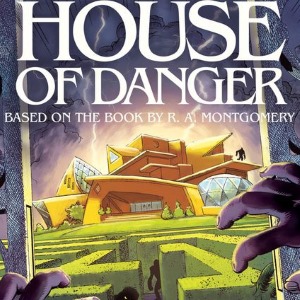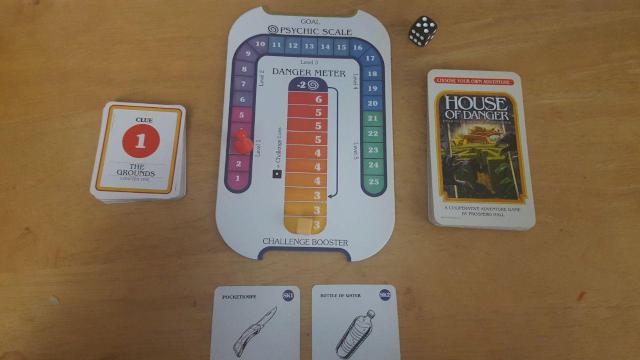
I loved Choose Your Own Adventure books when I was growing up. The idea of a story building up as a result of the choices I made was to exciting and novel that I could get through each book a couple of times before seeing the same passage twice, then do it all again with slight decision tweaks along the way. This was, let’s not forget, long before Telltale came along with their interactive video games like The Walking Dead with their decision-focussed gameplay that, to an extent, served a similar purpose. So when House of Danger appeared on our radar, a tabletop version of the classic Choose Your Own Adventure idea, it was too much to resist. So, without any spoilers, let’s take a look.

Before starting the game you get to look at an image on the back of the main card, showing you an image from the nightmares you’ve been having recently. As a detective and psychic investigator you’re convinced these images from your sleep mean something significant, so after a couple of minutes examining the picture it’s turned over and never seen again, much like waking up and trying to remember everything from a dream – you’ll remember a lot initially, but as the story presses on you’ll start to forget things.
The story is split into chapters, each one giving you a specific objective that you place at the top of the main board (where it says “goal”) – this is what you’ll be trying to complete in that specific chapter, but to get there you’ll have to take various decisions and complete certain challenges. These challenges come in the form of a dice roll, where you’ll usually need to roll something higher than your current spot on the Danger Meter, a track which determines how tricky it is to complete these challenges. You can pick up items and clues throughout which aid you in some of the challenges which is a nice physical element to separate this game from the books, and before too long you’ll be able to almost guarantee success by combining the various items you’ve got available when you roll the dice. There’s always a risk – if you roll a 1 you lose the challenge, no matter what else is going on – but it’s something that sets this game apart from simply reading your way through a book.
The story itself plays out by finding the relevant cards, reading that segment of the story and making your choices. Do you go into the maze or head towards the pool, do you examine an object closely or leave it alone, that kind of thing. Keeping your previous location available is important too; if you get killed at any point (which I did about 5 minutes in because I’m an idiot) you lose a couple of points on your psychic scale (used later to give you extra clues) and go back to the previous decision. It’s a nice way to let you explore and try things out without the fear of starting again, but as it carries a punishment of sorts there’s still the requirement to think about it.
The biggest issue I found though, was that if you want to stop playing at the end of a chapter you need to make a note of what equipment and clues you’ve got, then dig them out next time you play. You could place them separately in the box, but the quality of the box is pretty ropey as it is so there’s no guarantee the cards won’t end up getting mixed up anyway. There’s also an interesting concept at the end of each chapter where you can either move on or head back into the chapter to find other items that might be useful to you. That felt a little bit cheaty to me and I chose to plough on regardless, but maybe that’s just me looking for something closer to the style of books I remember as a kid. The completionists among you might feel the need to pop back and see how much stuff you can grab, hoping in the meantime you don’t end up getting yourself a bit killed in the process.
So my main concern about the extra components being a bit of a gimmick never really came to light. Instead the card system felt pretty good, and having physical items to keep in front of you in the form of clue cards was a nice way of bringing an inventory system into the Choose Your Own Adventure mechanism. The story is enjoyable, it’s replayable if you avoid retracing your steps after a chapter and there are enough different routes that you can play it a couple of times and still not see many of the cards on offer. It’s not excessively expensive either, and for something to play by yourself or without another person (I’m not sue I’d recommend anything above 2 players) when you’ve got an afternoon or evening to kill then it could be worth a look, especially if you remember the books as fondly as I do.

Leave a Reply